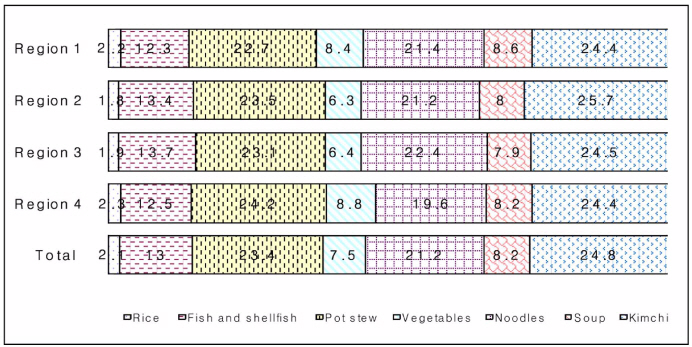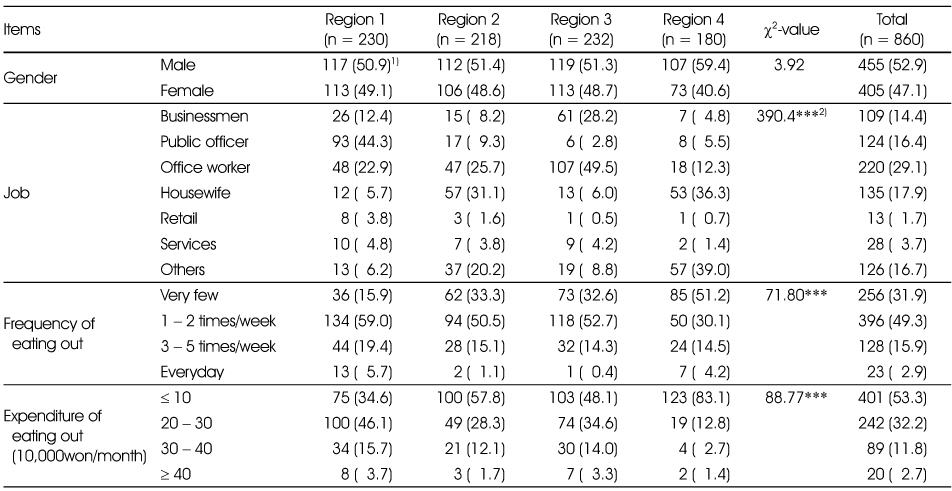Articles
- Page Path
- HOME > Korean J Community Nutr > Volume 17(1); 2012 > Article
-
Original Article
- A Comparison of Salty Taste Assessments and Dietary Attitudes and Dietary Behaviors Associated with High-Salt Diets in Four Regions in Korea
- Hyun-Hee Kim, Yun-Young Jung, Yeon-Kyung Lee
-
Korean Journal of Community Nutrition 2012;17(1):38-48.
DOI: https://doi.org/10.5720/kjcn.2012.17.1.38
Published online: February 29, 2012
Department of Food Science and Nutrition, Kyungpook National University, Daegu, Korea.
- Corresponding author: Yeon-Kyung Lee, Department of Food Science and Nutrition, Kyungpook National University, 1370 Sankyuk Dong, Buk-ku Daegu 702-701, Korea. Tel: (053) 950-6234, Fax: (053) 950-6229, yklee@knu.ac.kr
Copyright © 2012 The Korean Society of Community Nutrition
- 643 Views
- 0 Download
- 20 Crossref
Figure & Data
REFERENCES
Citations

- Estimation model for habitual 24-hour urinary-sodium excretion using simple questionnaires from normotensive Koreans
Ji-Sook Kong, Yeon-Kyung Lee, Mi Kyung Kim, Mi-Kyeong Choi, Young-Ran Heo, Taisun Hyun, Sun Mee Kim, Eun-Soon Lyu, Se-Young Oh, Hae-Ryun Park, Moo-Yong Rhee, Hee-Kyong Ro, Mi Kyung Song, Tatsuo Shimosawa
PLOS ONE.2018; 13(2): e0192588. CrossRef - Correlations Among Threshold and Assessment for Salty Taste and High-salt Dietary Behavior by Age
Lin Jiang, Yun-Young Jung, Yeon-Kyung Lee
Korean Journal of Community Nutrition.2016; 21(1): 75. CrossRef - Salt Preference and Sodium Intake among Pregnant Women
Mi Jeung Im, Dong Sook Cho
Korean Journal of Women Health Nursing.2016; 22(4): 297. CrossRef - Nutrition Knowledge, Dietary Attitude, and Dietary Behavior Related to Salt According to the Dietary Lifestyle Groups
Hei-Ryeo Yoon, Nam-E Kang, Juhyeon Kim
Korean Journal of Food & Cookery Science.2016; 32(3): 333. CrossRef - Healthy eating exploratory program for the elderly: Low salt intake in congregate meal service
Sunhee Seo, O.Y. Kim, J. Ahn
The Journal of nutrition, health and aging.2016; 20(3): 316. CrossRef - Comparison of salty taste assessment, high-salt dietary attitude and high-salt dietary behavior by stage of behavior change among students in Daegu
Hye-Hyun Hwang, Eun-Kyung Shin, Hye-Jin Lee, Tae-Yoon Hwang, Young Ae Kim, Yeon-Kyung Lee
Journal of Nutrition and Health.2016; 49(1): 36. CrossRef - Salt-Related Dietary Attitudes, Behaviors, and Nutrition Knowledge of University Students according to Estimated Salt Intake Using Urinary Salt Signal
Mi-Hyun Kim, Daun Min, Eungyoung Jang, Jee-Young Yeon, Jong Wook Kim, Yun-Jung Bae
Journal of the Korean Society of Food Science and Nutrition.2015; 44(2): 226. CrossRef - A Study on Sodium-related Dietary Attitude and Behaviors According to Sodium-related Nutrition Knowledge of University Students
Mi-Hyun Kim, Jee-Young Yeon, Jong Wook Kim, Jae-Eon Byun, So-Young Bu, Mi-Kyeong Choi, Yun-Jung Bae
Korean Journal of Community Nutrition.2015; 20(5): 327. CrossRef - Sodium-related Eating Behaviors of Parents and Its Relationship to Eating Behaviors of Their Preschool Children
Ye Seul Kim, Hong Mie Lee, Jung Hee Kim
Korean Journal of Community Nutrition.2015; 20(1): 11. CrossRef - Study on Sodium-related Dietary Attitude, Behaviors according to Practice of Dietary Guidelines of University Students
Yun-Jung Bae, Seung-Eun No, Jeong-Hwa Seo, Joo-Hee Son, Mi-Jin Lee, Da-Woon Jung
The Korean Journal of Food And Nutrition.2015; 28(3): 376. CrossRef - A Comparison of Salty Taste Assessment, Dietary Attitude and Dietary Behavior among Adult and Senior Women by Region and by Age in Korea
Lin Jiang, Yun-Young Jung, Hyung-Sook Kim, Gi-Seon Nam, Jin-Sook Yun, Jong-Wook Kim, Yeon-Kyung Lee
Korean Journal of Community Nutrition.2015; 20(2): 109. CrossRef - The Relationship between Dietary Behaviors/health Risk Factors and Preference for Salty Taste among Korean Elderly People Living in Rural Areas
Mee Sook Lee
Korean Journal of Community Nutrition.2014; 19(5): 448. CrossRef - Salt-related Dietary Behaviors of University Students in Gyeongbuk Area
Kyung-A Lee
Journal of the Korean Society of Food Science and Nutrition.2014; 43(7): 1122. CrossRef - A Study on the Knowledge, Dietary Behavior related to Sodium, Attitudes towards a Low-Salt Diet of Adults in the Jeonbuk Area
Jeongok Rho, Hyuna Kim
Korean Journal of Human Ecology.2013; 22(4): 693. CrossRef - Analysis of presumed sodium intake of office workers using 24-hour urine analysis and correlation matrix between variables
Hyun-Hee Kim, Yeon-Kyung Lee
Korean Journal of Nutrition.2013; 46(1): 26. CrossRef - Comparison of Salty Taste Assessment and High-Salt Dietary Behaviors among University Students and Chinese Students in Daegu, South Korea and University Students in Shenyang, China
Lin Jiang, Yeon-Kyung Lee
Korean Journal of Community Nutrition.2013; 18(6): 555. CrossRef - The Development of a Taste Kit for Education and Research into Sensory Characteristics
Mi-Hye Kim, Hae-Kyung Chung
Journal of the Korean Society of Food Culture.2013; 28(6): 585. CrossRef - Association between Preferences of Salty Food and Acuity and Preferences of Taste of the Elderly People Living in Rural Area
Mee Sook Lee
Korean Journal of Community Nutrition.2013; 18(3): 223. CrossRef - The Association between Smoking, Alcohol Intake, and Low-Salt Diet: Results from the 2008 Community Health Survey
In-Ae Chun, Jong Park, Mi-Ah Han, Seong-Woo Choi, So-Yeon Ryu
Journal of the Korean Dietetic Association.2013; 19(3): 223. CrossRef - Measurements of Salinity and Salt Content by Menu Types Served at Industry Foodservice Operations in Daegu
Ji-Ae Kim, Yun-Hwa Kim, Moon-Young Ann, Yeon-Kyung Lee
Korean Journal of Community Nutrition.2012; 17(5): 637. CrossRef

Fig. 1
Anthropometric measurements of the subjects
1) Mean ± SD
2) Values with the different superscript are significantly different among different areas by Duncan's multiple range test
3) *: p < 0.05, ***: p < 0.001
4) BMI: Body Mass Index = Weight (kg) / Height (m)2
5) SBP: Systolic Blood Pressure, 6) DBP: Diastolic Blood Pressure
General characteristics of the subjects
1) N (%), 2) ***: p < 0.001
Comparison of salty taste assessment among regions
1) Mean ± SD, 1: unsalty, 2: slightly unsalty, 3: so-so, 4: slightly salty, 5: salty
2) NS: Not significant
3) *: p < 0.05
4) Adjusted for age, gender, job, frequency of eating out and expenditure of eating out
Comparison of nutrition knowledge by salty taste assessment among regions
1) Mean ± SD, Total score = 10
2) Values with the different superscript are significantly different among different concentration by Duncan's multiple range test
3) *: p < 0.05, **: p < 0.01, ***: p < 0.001
4) Values with the different superscript are significantly different among different areas by Duncan's multiple range test
5) Adjusted for age, gender, job, frequency of eating out and expenditure of eating out
6) Values with the different superscript are significantly different among different areas by ANCOVA & Bonferroni comparison test
Comparison of eating attitude by salty taste assessment among regions
1) Mean ± SD, Total score = 5
2) Values with the different superscript are significantly different among different concentration by Duncan's multiple range test
3) **: p < 0.01, ***: p < 0.001
4) Values with the different superscript are significantly different among different areas by Duncan's multiple range test
5) Adjusted for age, gender, job, frequency of eating out and expenditure of eating out
6) Values with the different superscript are significantly different among different areas by ANCOVA & Bonferroni comparison test
Comparison of eating behavior by salty taste assessment among regions
1) Mean ± SD, Total score = 5
2) Values with the different superscript are significantly different among different concentration by Duncan's multiple range test
3) *: p < 0.05, **: p < 0.01, ***: p < 0.001
4) Adjusted for age, gender, job, frequency of eating out and expenditure of eating out
Correlation matrix between sodium intake and variables
*: p < 0.05, **: p < 0.01
Correlation coefficients among nutrition knowledge, salty taste assessment, eating attitudes, and eating behavior
**: p < 0.01, ***: p < 0.001
1) Mean ± SD 2) Values with the different superscript are significantly different among different areas by Duncan's multiple range test 3) *: p < 0.05, ***: p < 0.001 4) BMI: Body Mass Index = Weight (kg) / Height (m)2 5) SBP: Systolic Blood Pressure, 6) DBP: Diastolic Blood Pressure
1) N (%), 2) ***: p < 0.001
1) Mean ± SD, 1: unsalty, 2: slightly unsalty, 3: so-so, 4: slightly salty, 5: salty 2) NS: Not significant 3) *: p < 0.05 4) Adjusted for age, gender, job, frequency of eating out and expenditure of eating out
1) Mean ± SD, Total score = 10 2) Values with the different superscript are significantly different among different concentration by Duncan's multiple range test 3) *: p < 0.05, **: p < 0.01, ***: p < 0.001 4) Values with the different superscript are significantly different among different areas by Duncan's multiple range test 5) Adjusted for age, gender, job, frequency of eating out and expenditure of eating out 6) Values with the different superscript are significantly different among different areas by ANCOVA & Bonferroni comparison test
1) Mean ± SD, Total score = 5 2) Values with the different superscript are significantly different among different concentration by Duncan's multiple range test 3) **: p < 0.01, ***: p < 0.001 4) Values with the different superscript are significantly different among different areas by Duncan's multiple range test 5) Adjusted for age, gender, job, frequency of eating out and expenditure of eating out 6) Values with the different superscript are significantly different among different areas by ANCOVA & Bonferroni comparison test
1) Mean ± SD, Total score = 5 2) Values with the different superscript are significantly different among different concentration by Duncan's multiple range test 3) *: p < 0.05, **: p < 0.01, ***: p < 0.001 4) Adjusted for age, gender, job, frequency of eating out and expenditure of eating out
*: p < 0.05, **: p < 0.01
**: p < 0.01, ***: p < 0.001

 KSCN
KSCN









 PubReader
PubReader Cite
Cite


